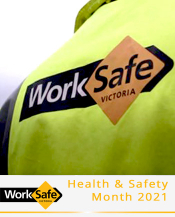Dangerous Goods (Storage & Handling) – New Regulations Explained
Over the last two weeks of Health and Safety Month 2021, WorkSafe Victoria ran free 45-minute webinars on a variety of topics. The theme for the month was “You learn something new every day”. I attended the session about the new Dangerous Goods (Storage & Handling) Regulations, which was presented by members of the WorkSafe Dangerous Goods Strategic Inspection Team as well as one of their Senior Dangerous Goods Advisors.
The 2018 fire in West Footscray and the 2019 fire in Campbellfield resulted in a review of the DG Regulations, particularly around the notification to WorkSafe of the storage of large quantities. This resulted in an amendment to the regulations, which came into effect on the 1st July 2021. Prior to this, occupiers storing above ‘manifest’ quantities were required to notify WorkSafe every 5 years using the prescribed hard copy proforma. As of 1st July 2021, occupiers now must notify WorkSafe every 2 years. Importantly, occupiers must re-notify WorkSafe before the end of the 2021 calendar year despite what their current certificate states.
Notification can now only be made via the online proforma/portal located on the WorkSafe website https://www.worksafe.vic.gov.au/dangerous-goods-storage-and-handling-notification
Extra information required includes the packing group of the chemical, and information confirming the written advice from the emergency services (fire authority), as required by regulation 55. In addition, occupiers must submit a new notification when there are changes to the quantities stored (above manifest quantities).
The DG Strategic Inspection Team at WorkSafe was created to look after about 230 sites that store large quantities of dangerous goods, excluding Major Hazard sites. They include sites with a potential for an off-site impact, e.g. toxic release, and cover a range of industrial sectors, i.e. food manufacturers, cold storage sites and water treatment businesses.
There are 6 inspectors in the team and each is assigned a specific business. In a number of instances the have made joint visits to sites with Fire Rescue Victoria and the EPA. The main areas they examine are: the risks of the business; control of ignition sources; emergency planning; fire protection systems; waste storage; maintenance of equipment; permit-to-work systems; induction and training with respect to dangerous goods. There are also 4 senior DG advisors, who support the inspectors and authorised explosive offices. They also participate in various DG regulatory committees.
Information that came out of the Q&A session:
• Hard copies of Safety Data Sheets (SDSs) are still required for transport drivers.
• The chemical manifest (where required) must be displayed at the main entrance to a site, with multiple copies required for multiple locations.
• Quantities of waste chemicals must be included on the manifest.
• No on-the-spot fines (infringement notices) are currently applicable to this legislation.
• Emergency services require hard copies of SDSs in the red emergency box, especially those for high risk chemicals.
• Employees need to be trained to deal with emergencies.
WorkSafe Victoria will make an edited version of the webinar available on their website in late November.



